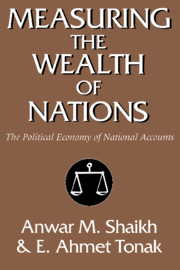Book contents
- Frontmatter
- Contents
- List of figures
- List of tables
- Preface
- 1 Introduction
- 2 Basic theoretical foundations
- 3 Marxian categories and national accounts: Money value flows
- 4 Marxian categories and national accounts: Labor value calculations
- 5 Empirical estimates of Marxian categories
- 6 A critical analysis of previous empirical studies
- 7 Summary and conclusions
- Appendices
- References
- Author index
- Subject index
3 - Marxian categories and national accounts: Money value flows
Published online by Cambridge University Press: 09 February 2010
- Frontmatter
- Contents
- List of figures
- List of tables
- Preface
- 1 Introduction
- 2 Basic theoretical foundations
- 3 Marxian categories and national accounts: Money value flows
- 4 Marxian categories and national accounts: Labor value calculations
- 5 Empirical estimates of Marxian categories
- 6 A critical analysis of previous empirical studies
- 7 Summary and conclusions
- Appendices
- References
- Author index
- Subject index
Summary
The purpose of this chapter is to develop a mapping between Marxian categories and those of conventional national accounts. The essential points of the argument will be presented here, with all further detail reserved for Appendix A.
National income and product accounts (NIPA) are the traditional base for national accounting. But input–output (IO) tables provide a more general framework in that they encompass both interindustrial flows and national income–product flows. We will therefore use IO tables as our basic theoretical and empirical foils.
Although IO accounts provide a superior description of the economy for our purposes, they suffer from the drawback of being available only for benchmark years (1947, 1958, 1963, 1967, 1972, 1977) for the United States. We will therefore use these tables only to provide comprehensive benchmark estimates, which will then be expanded into annual series using NIPA data.
Our project requires distinguishing between three different sets of measures, for which we adopt different notation: Marxian labor value measures such as constant capital, variable capital, and surplus value (C, V, S); their money forms (C*, V*, S*); and corresponding IO–NIPA aggregates such as intermediate inputs, wages, and profit-type (unearned) income (M, W, P). Since all accounts in question will be double-entry accounts, each of the revenue-side flows will have use-side counterparts (such, as U for the Marxian labor value of the inputs used in production, U* for the corresponding Marxian money value, and M for the orthodox measure of intermediate inputs on both revenue and use sides).
- Type
- Chapter
- Information
- Measuring the Wealth of NationsThe Political Economy of National Accounts, pp. 38 - 77Publisher: Cambridge University PressPrint publication year: 1994

